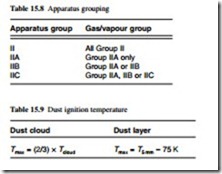Equipment selection
Although further selection criteria may be relevant, such as the possibility of chemical attack, vibration, and high risk of mechanical damage, the four essential criteria for equipment selection are:
● the protection concepts and ATEX category are suitable for the intended zone of use (Table 15.7)
● the Apparatus Grouping is suitable for the intended flammable materials (Table 15.8, which applies only to gases and vapours)
● the Temperature Class or surface temperature is suitable for the ignition temperature of the flammable material (Table 15.6)
● the Ambient Temperature limits for the equipment are suitable for the intended location
A combustible dust has two ignition temperatures, one for the dust in the form of a cloud (Tcloud) and the other for the dust as a layer. These temperatures depend on the physical properties of the dust, such as particle size, moisture content, and the layer ignition temperature increases as the layer thickness increases. Consequently, large safety margins between the equipment temperature (Tmax) and the dust ignition temperatures are used (Table 15.9). In Europe, dust layer ignition temperatures are usually measured with 5 mm thick layer (T5mm) but in USA, a 12.5 mm layer is used.
If dust layers are expected to exceed 5 mm the derating graph given in BS EN 50281-1-2:1999 (reference 15Q) may be used. If dust layers are expected to exceed 5 mm and T5 mm is also 250°C or less, special precautions are given.
Equipment for combustible dust applications has additional special ingress protection requirements, given in BS EN 50281-1-2:1999, and summarized in Table 15.10. The general criteria for ingress protection are covered in Chapter 10 and in section 16.2.2.1.

